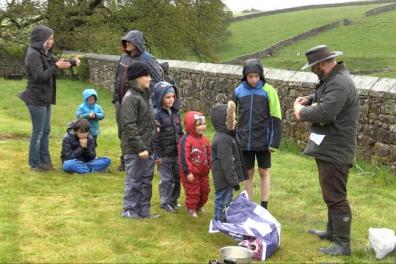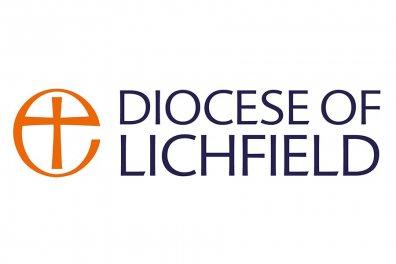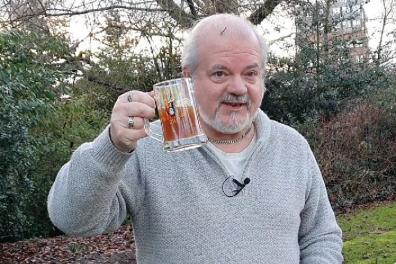What is Forest Church?
Forest Church began as a movement in 2012 for people who encountered God in nature and wanted to offer a way of being ‘church’ for others whatever their faith background who sensed nature as a place of spiritual encounter. A number of us were exploring what ‘church’ would look like for people for whom spirituality was something explored in nature and we were in part inspired by the Forest School movement, now quite common in the school system, in which children learn outdoors in nature. From this the idea of forming Forest Churches emerged.
You don't need a forest to run a Forest Church, indeed they have happened in urban areas as well as rural, and people’s gardens as well as larger open spaces. All you need is somewhere to explore being with God in nature. There is no set form for how you run a Forest Church, they can contain prayers and songs and meditations. They can be done on a walk, or round a fire or round a meal table. The essential thing is it happens with nature and is not simply ‘church outdoors’. Many Forest Churches involve craft activities and food as well as worship and reflection. They are about celebrating the seasons and often feature seasonal produce and crafts and the reviving of older traditions from times when most people lived closer to nature. They are naturally ‘all age’ events and often attract people who wouldn’t otherwise go to church. Because they are attentive to the environment, they are about caring for and listening to the environment so are also a natural way to be ‘church’ in an age of climate crisis and creation care. You can find out more about the Diocese and the Environment here. Forest Church is a movement of like minded people rather than an organisation or programme and there are other similar groups that go by different names like Wild Church which has been popular with very similar ethos in the United States but some groups also use here, indeed in this Diocese.
The Forest Church calendar and the ‘Celtic’ seasonal festivals
Most Forest Churches operate on what is often understood as an ancient Celtic seasonal cycle. In truth there is not enough evidence for this being really ancient, but it certainly is part of what shaped the dates of Christian celebrations in the early medieval period and is often followed today by other nature connected traditions, so it works as a basis for celebrating the turn of the seasons. This cycle is based on the solstices and equinoxes, and between them days when the seasons begin to turn.
The first festival then in our calendar year is at Candlemas on 1 February, which is also around the feast day of St Brigid. As the snowdrops emerge from the ground and the presentation of Jesus in the Temple marks the end of the 40 days of Christmas, we turn from winter to look for the first signs of spring. Traditionally this was when you took down your Christmas tree (only put up on Christmas eve) and it was burnt and from the candles to light the church were lit. Our customs today have become very different, but in Forest Church as we revive older customs, we also rediscover our seasons and their particular gifts to us.
The next festival is the feast of the annunciation or ‘lady day’. This is on 25 March which was the date of the Spring Equinox in the old Roman Calendar before the modern calendar was adopted we use today. Traditionally the 25 March was considered to be the date of the first Easter and there was a discussion in the early church about fixing it on that date rather than it moving, like the Jewish Passover, according to a lunar rather than a solar cycle. So new life in the spring is celebrated as the days move from the dark half of the year to the light.
May Day, the next festival, marks the first signs of summer and is also the feast of Mary and Joseph and a celebration of home and family. Close before is St George’s day and close after that of St Julian of Norwich and often these three can be a focus of Christian celebration as well as reviving where possible traditional May Day activities like maypoles and morris dancing.
Again, before the calendar change, Midsummer was on 25 June: in the early church the feast days of St Alban and St john the Baptist were set around Midsummer. Both these saints, like the tradition of many Celtic saints die by being beheaded. Stories surrounding their martyrdoms are interwoven with other seasonal stories marking the constant shift from summer to winter as battle between holly and oak that appears also in stories like Gawain and the Green Knight. There’s also a tradition of rose cakes eaten at Midsummer which is tasty thing to revive.
Lammas on 1 August marks the start of the harvest season and the first signs of autumn. This may seem strange as schools in Britain have their ‘summer holidays’, but we forget that the dating of these is a long way from midsummer and was designed to enable the children to join in the grain harvest. Calendar shifts and changing weather mean that our grain harvest is not always at the start of August, but this is a good time to celebrate bread and beer (gluten free versions often also necessary!) and reflect on the way we need to live well with nature and see it as a precious gift.
The Autumn Equinox falls traditionally on 25 September and this marks the Annunciation of John and close on Michael and All Angels. The year shifts from the light half to the dark, and we seek Michaels gift of God’s protection in the darker months and look to the light in the darkness of Christmas.
All Hallows on 1 November and All Hallows Eve marked both the end of the harvest with the apple harvest but also a season of remembrance as people entered the season of winter. These were marked by apple games and remembrance of the dead long before older customs became our commercialised horror film themed contemporary Halloween. Reviving old Christian customs is a good way to enter into this season without some of the elements that can be of concern in some contemporary expressions. It’s also nice to drink some mulled cider round a fire as the seasons get colder!
Christmas at the Winter Solstice marks the end of the year as the light comes in the darkest day of the year, traditionally on 25 December. Often in Forest Church it has worked better to gather at the feast of the Epiphany to fit with other family celebrations and also the themes of the revelation of Jesus in that festival are also good to draw on.
Please click on the following link for a zip file of Seasonal Resources for Forest Church.


